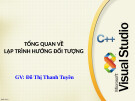
LẬP TRÌNH
HƯỚNG ĐỐI TƯỢNG (OOP)
ÔN TẬP

11/26/15 Khoa Công nghệ phần mềm 2
NỘI DUNG
•Khái niệm OOP
•Khai báo lớp
•Overloading
•Kế thừa
•Đa hình

3
Khái ni mệ
•Object-oriented programming (OOP)
–Đóng gói d li u(thu c tính) và ch c năng(hành vi) thành ữ ệ ộ ứ
gói g i là l p(class)ọ ớ
•Che d u d li u(Information hiding) ấ ữ ệ
–Các đi t ng c a l p giao ti p thông qua giao di n.ố ượ ủ ớ ế ệ
–Chi ti t cài đt đc che d u.ế ặ ượ ấ
•Ki u d li u ng i dùng đnh nghĩa: classesể ữ ệ ườ ị
–Data (data members)
–Functions (member functions or methods)
–Class instance: object

4
L ch s C++ị ử
–M r ng c a Cở ộ ủ
–Đu th p niên 1980: Bjarne Stroustrup (Bell Laboratories)ầ ậ
–Cung c p kh năng l p trình h ng đi t ngấ ả ậ ướ ố ượ
•Objects
•Object-oriented programs
–Ngôn ng laiữ
•C-like style
•Object-oriented style
•Both

5
Cài đt l p Timeặ ớ
•L pớ
–Mô hình đi t ngố ượ
•Thu c tính (data members) ộ
•Hành vi (member functions)
–Khai báo v i t khóa ớ ừ class
–Member functions
•Methods
•Invoked in response to messages
•T khoá xác đnh ph m vi truy c pừ ị ạ ậ
–public:
•Truy c p b i đi t ng c a l p b t c n i nàoậ ở ố ượ ủ ớ ở ấ ứ ơ
–private:
•Truy c p b i các hàm thành viên c a l pậ ở ủ ớ
–protected:
















![Tài liệu ôn tập môn Lập trình web 1 [mới nhất/chuẩn nhất]](https://cdn.tailieu.vn/images/document/thumbnail/2025/20251208/hongqua8@gmail.com/135x160/8251765185573.jpg)









